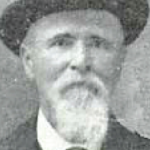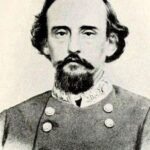
THE BATTLE OF LAFAYETTE
JUNE 24, 1864
In June 1864, the Confederate Army of Tennessee occupied a strong defensive position along Kennesaw Mountain. General Joseph E. Johnston urged his government to unleash a cavalry force on into “General William T. Sherman’s rear to play havoc with the Federal lifeline, the Western and Atlantic Railroad.”
Johnston wanted Nathan Bedford Forrest to strike the enemy supply line. One historian noted “instead, he got one of the Confederacy’s worst (generals) Brigadier General Gideon Pillow.”
Pillow received orders to move from Oxford, Ala. into north Georgia and interrupt Union General William T. Sherman’s supply line south of Chattanooga. To make this raid, Pillow would have Colonel James J. Neely’s West Tennessee Brigade (including Tipton’s men in the 12th Tennessee Cavalry) and a brigade of Alabama and Mississippi regiments under command of Colonel Charles G. Armistead. No artillery was available to accompany the raiders.
Neely’s troops were ordered to prepare four day’s cooked rations and to issue 40 rounds of ammunition the the men, on June 18. The next day Neely was directed to take only 600 of his troopers for the expedition (his wagons and disabled horses and men were sent to the rear). The column, 1,200 men, left Blue Mountain, Alabama on the 20th. The Alabama Brigade took the lead with the Tennesseans following. They rode to Jacksonville, Alabama were the Alabamians were able to cross the rain-swollen Coosa River. Neely’s Tennesseans had to ride to Gadsden where it took him all night on June 21-22 to ferry his men and horses over the river. On the 22nd Pillow’s raiders arrived at Blue Pond where they received fresh rations. Culling out weak horses and “invalid” soldiers, Pillow reduced his command to about 1,000 men.
From Blue Pond the command moved northeast to Gaylesville, then turning north for Alpine, Ga. and then east to Summerville where they arrived about nightfall on the 23rd. Men and horses were dead tired and jaded.
Upon arriving at Summerville, Pillow learned that a Union cavalry command was stationed at the town of LaFayette, only 20 miles north of his present location. Pillow later reported that he did not want to leave enemy troops on his flank and rear, so he made the decision to attack these troops before moving farther east to attack the Western and Atlantic Railroad, which was vital to Sherman’s army.
Federal cavalry had occupied La Fayette since June 19. Colonel Louis D. Watkins, a Georgian by birth, commanded the 3rd Brigade, 1st U. S. Cavalry Division, about 450 men of the 4th, 6th and 7th U. S. Kentucky cavalry. Watkins’ headquarters were in the Goree Hotel on the town square, while his men were quartered in adjacent buildings and tents.
Continued next week.





